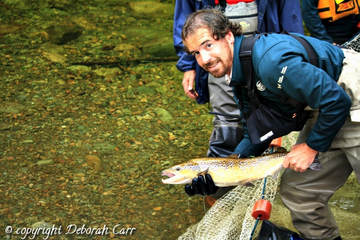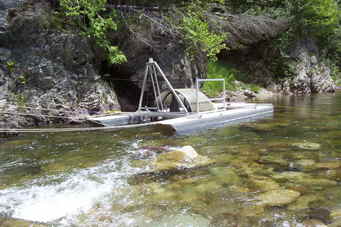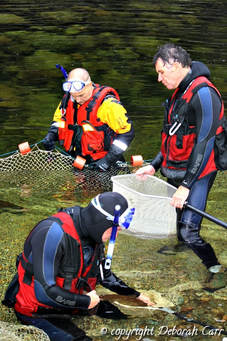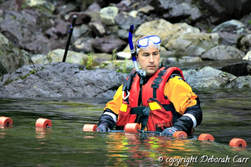 Corey Clark, Ecologist Team Leader FNP
Corey Clark, Ecologist Team Leader FNP Wild Atlantic salmon populations have been declining dramatically for decades. Endangered since 2002, the decline of the wild iBoF Atlantic salmon population has been well documented but poorly understood. Fundy Salmon Recovery is looking to change that. With a unique migration limited to the Bay of Fundy, and a portion of their freshwater range protected within Fundy National Park, iBoF Atlantic salmon provide a globally unique research and recovery opportunity. Fundy Salmon Recovery, now running an advanced program has created a conservation model for other recovery efforts worldwide.
“The Fundy Salmon Recovery project is a demonstration of Parks Canada’s leadership in conservation management. Through innovation and collaboration, Parks Canada is achieving success in the recovery of Atlantic salmon, an iconic species at risk that is valued by Canadians and by Atlantic Canada’s indigenous communities. The growing presence of inner Bay of Fundy salmon in Fundy National Park reflects this government’s commitment to protect and maintain the ecological integrity of this treasured place.”
The Honourable Catherine McKenna, Minister of Environment and Climate Change and Minister responsible for Parks Canada
|
Together, they've pioneered the world's first Wild Atlantic Salmon Marine Conservation Farm at Dark Harbour, off Grand Manan Island, NB, where wild Atlantic salmon taken from their native iBoF rivers are protected, grown to maturity and released back to Fundy National Park and into the Petitcodiac watershed. This project is a true collaboration of community and industry stakeholders working together to protect young wild Atlantic salmon and improve their chances of survival when released back to the wild as adults. Their goal is to increase the number of spawning salmon in the inner Bay of Fundy and save the species from extinction. |
The Fundy Salmon Recovery Partnership
|
How they do it
 A smolt wheel, like this, is used to collect juvenile salmon from their native rivers.
A smolt wheel, like this, is used to collect juvenile salmon from their native rivers. “As long standing partners with Fundy National Park, we are so proud to be part of this innovative approach in recovery of Atlantic salmon here in the park and on the Petitcodiac River. Salmon are so important to us and are an essential part of a healthy ecosystem on which we all depend; we are happy to have this opportunity to reconnect our youth with the land and this iconic species through this work.”
Rebecca Knockwood, Chief of Fort Folly First Nation

The aim is to collect the young fish after they have spent the critical early life stages in the wild, then care for them in a controlled ocean environment. The site is equipped with custom designed conservation aquaculture net pens – the first of its kind in the world. The fish are fed specialized diets developed by biologists and Cooke Aquaculture nutrition experts.
Once the salmon are mature they are released back into Fundy National Park rivers and the Petitcodiac watershed where the survival of their offspring, from egg to young salmon, will continue the cycle.
Back in the rivers, salmon are continuously monitored by University of New Brunswick scientists. Using advanced technology, scientists are able to detect the number of project salmon and wild returning salmon that enter and depart the Upper Salmon River in Fundy National Park. They are also monitoring wild returning salmon genetics, river nutrient levels and ecosystem health.
“Fisheries and Oceans Canada is a proud partner of this collaborative project that is showing great potential in restoring the endangered inner Bay of Fundy Atlantic salmon to Fundy National Park and the Petitcodiac River. Our department has worked since the late 1990’s to maintain this population through Live Gene Banking in the hopes that this iconic species will recover. When it comes to conservation and rebuilding stocks, we all have a role to play, which is why partnerships such as these are so important.”
The Honourable Dominic LeBlanc, Minister of Fisheries, Oceans and the Canadian Coast Guard.
 FNP ecologist, Dan Mazerolle coralles salmon with seine nets for counting and sampling
FNP ecologist, Dan Mazerolle coralles salmon with seine nets for counting and sampling  RSS Feed
RSS Feed